Rosie Whicheloe, London Borough of Sutton Biodiversity Net Gain Officer
Most dictionary definitions broadly define a “park” as a large area of grass with some trees where people can go for recreation. But there is so much more to a park than just this simple description and whimsical pleasure. In Sutton, the 20 plus Friends of Park Groups are testament to the value of parks to local residents, all of which are made up of volunteers raising funds and getting stuck in with practical management. There is a swathe of research that underpins parks and their value for our mental wellbeing (one example is here) and they can be incredibly important to wildlife too, neither of which the standard “park” definition alludes to.
For a borough on the edge of London, Sutton contains a surprising array of wildlife (if you’re unfamiliar with how diverse it is). Nationally declining or rare species such as the small blue butterfly, the flowering plant greater yellow rattle, invertebrates such as the stag beetle and mayfly, and birds such as the skylark all live in Sutton, and it’s in the borough’s nature reserves and Sites of Importance for Nature Conservation (SINCs for short) where much of this diversity resides.
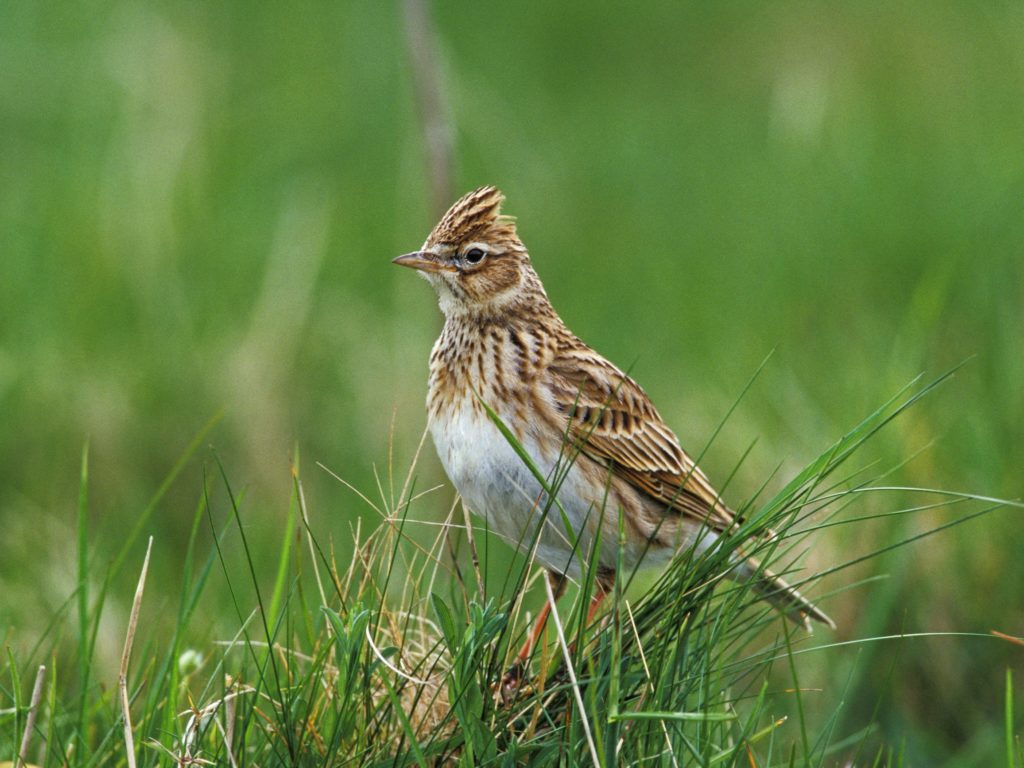
There are 50 SINCs in the borough, which are designated through the council’s Local Plan for the important wildlife and species-rich habitats they support. In Sutton, this includes priority habitats such as chalk meadows, lush wetlands, mature woodland and chalk rivers like the Wandle. The map below shows the relationship between Sutton’s parks, recreational areas and SINCs. The bars represent the number of different plant species that have been recorded at various sites, although abundance and rarity are also important aspects in determining ecological value. Whilst there are a number of private SINCs, many have free public access and are located in parks, which shows that parks are more than just grass and some trees as the definition would suggest.
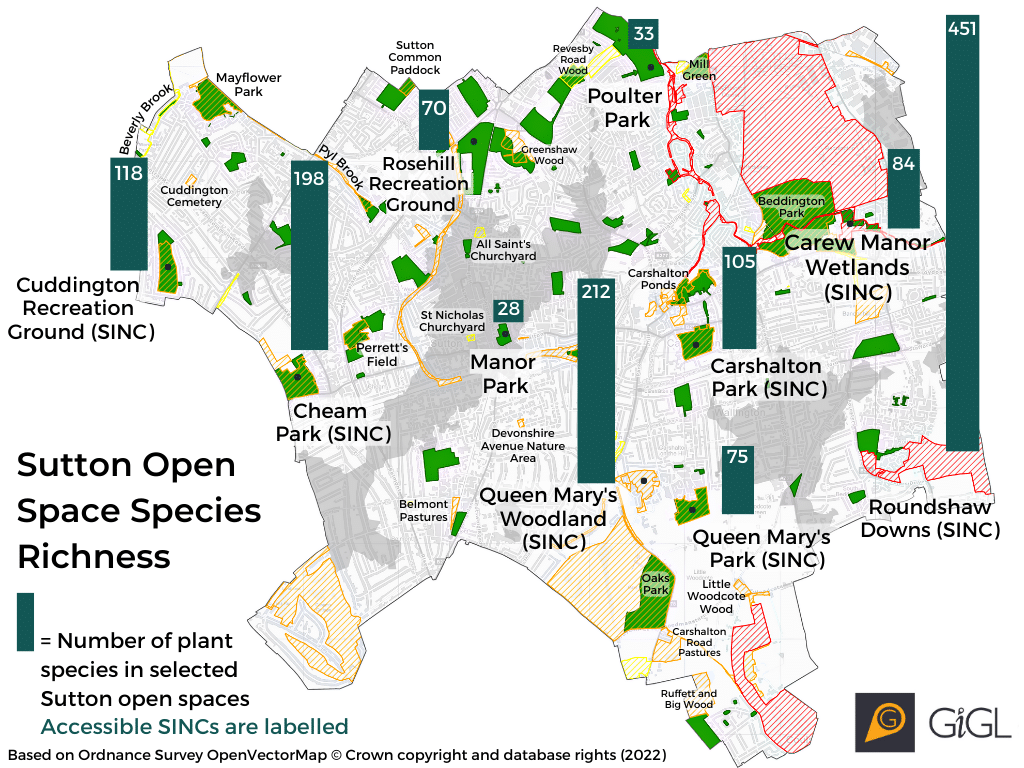
In a similar way to park Friends of Groups, SINCs in Sutton are managed by Sutton Nature Conservation Volunteers (SNCV) who accompany paid staff to manage and enhance the borough’s SINCs on a weekly basis. As well as volunteering, there are various ways in which you can engage with this aspect of your local park – have you seen Sutton’s Explorer’s Map? There is also the nature information guide which describes some of the important habitats and the variety of wildlife they support.
While the overlap of SINCs and parks brings many benefits, it can also lead to some challenges as all users need to be taken into account. For instance, dogs running free through long grass isn’t compatible with providing a safe refuge for breeding birds or hiding hedgehogs. On a similar note, a nine-am stampede of runners taking part in an organised park-run might be good exercise, but is best avoided in some locations, due to disturbance or trampling of sensitive species or habitats. These factors will all need to be taken into account at Beddington Farmlands, which will be one of London’s next major nature reserves. Dogs and runners may need to be excluded from certain areas to avoid damage, while fencing and signage can help visitors respect the multi-functional nature of parks and the need for cooperation.
Another example is through the Council’s Biodiversity Strategy that sets out sheep and cattle grazing as the preferred method of managing wildflower meadows. This is because they engineer a patch-work of micro-habitats not achievable with mechanical mowing and haymaking, in turn increasing the soil’s capacity to store carbon. With close-working between the Friends of Groups, the Parks Service and Sutton’s Biodiversity Team, it is hoped more meadow habitats could be managed in this way, which in turn will bring wider benefits to wildlife and climate amelioration.
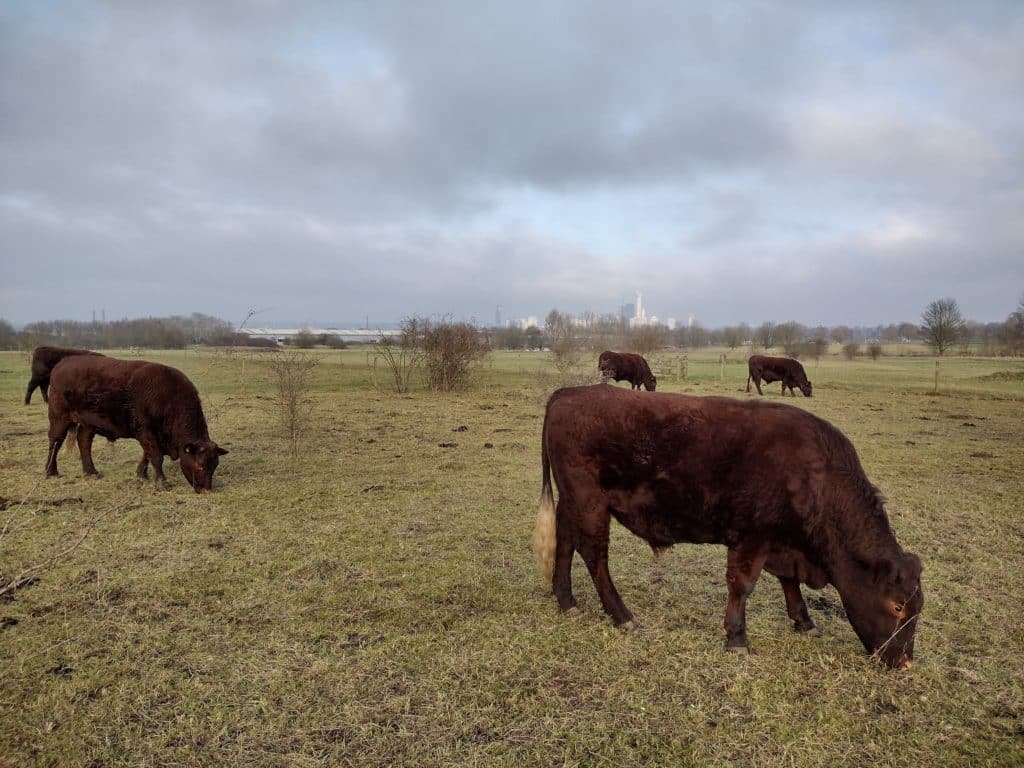
With these challenges in mind, another important attribute of parks that overlap with SINCs is that research suggests that nature-rich places are better for us (one example is here). This was highlighted earlier in the year by an article in the national news, but has been known much longer in London, through Areas of Deficiency in Access to Nature maps (SINC AoD). This is defined as areas that are greater than a 10-12 minute walk (or 1000 km distance) to a Borough grade SINC or higher. Craig Bennett, the Chief Executive of The Wildlife Trusts, said: “Having access to wild places and wildlife shouldn’t be a privilege, but a part of everyday life. We know how much people treasure time spent in nature near where they live, but for many communities this simply isn’t possible. The most deprived areas have nine times less green space than the wealthiest – and poorer areas are where people’s health is the worst”.
The map below provides an overview of London’s Areas of Deficiency in Access to Nature, based on borough percentages. The higher the percentage the less access to nature residents in that borough have. In Sutton, 10-15% of the total area is classified as deficient, which means that there is slightly more access to nature than in any of its nearest neighbours.
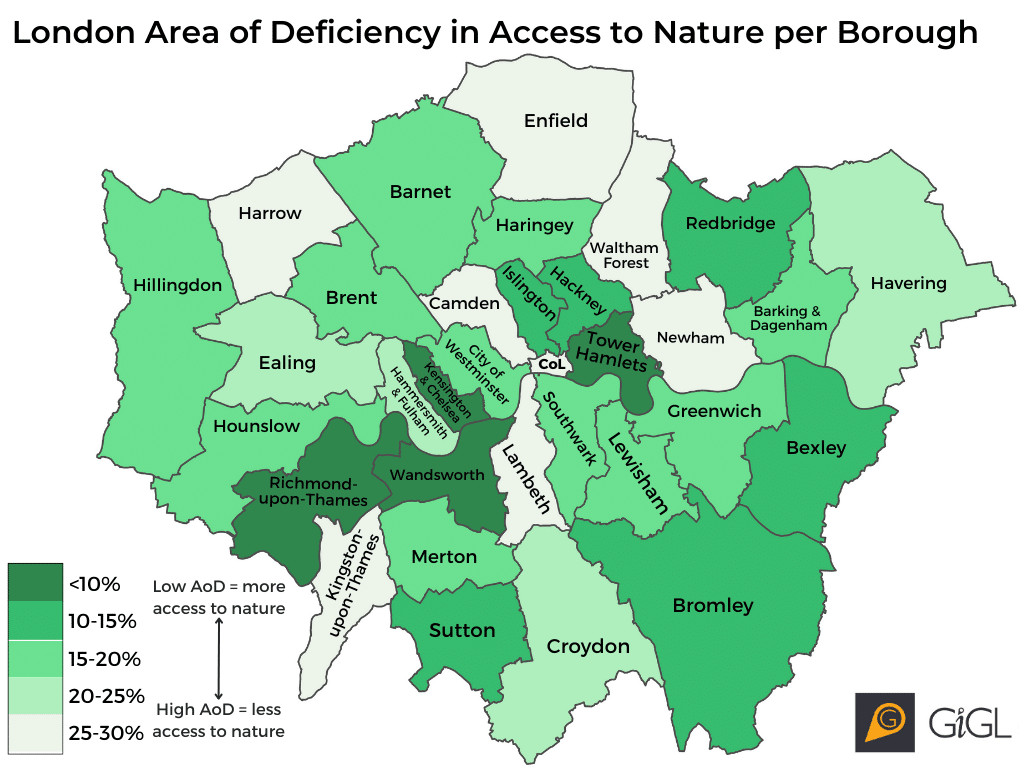
The final map below shows that Sutton’s SINC AoD (in grey) is located north and south of Sutton Town Centre, east of Beddington Farmlands, west of Fairlands Park and north of Woodcote Green. How can the council, through the review of the Local Plan, address these deficiencies in a strategic manner?
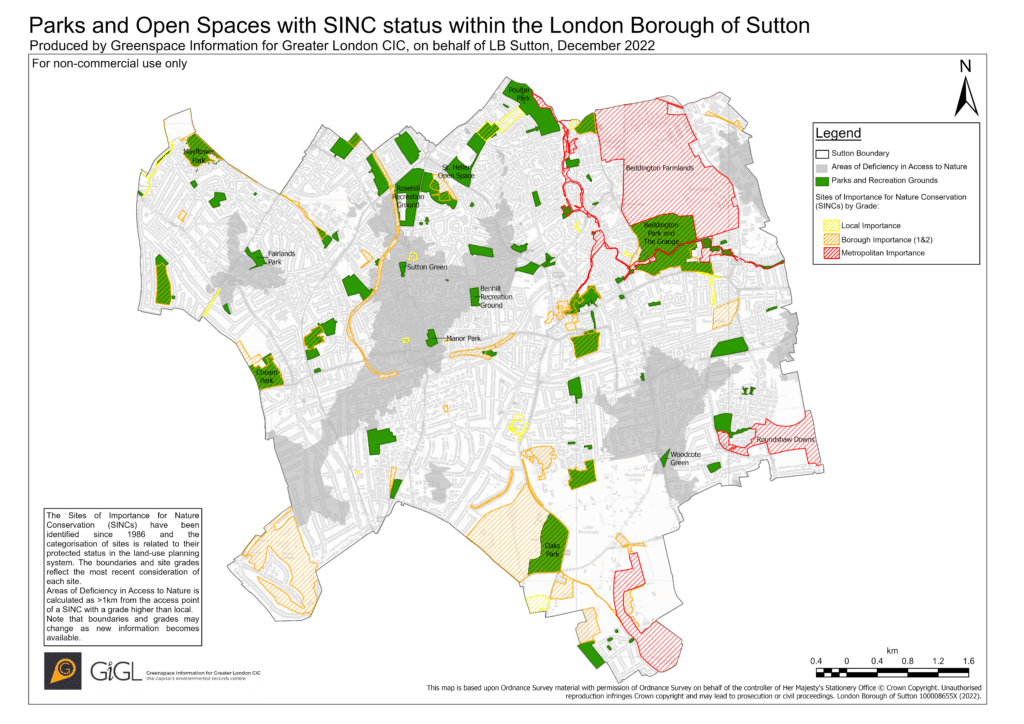
Enhancing existing parks to be more multi-functional should be encouraged wherever possible, as this is likely to be the simplest and cheapest option. Opportunities to enlarge existing parks or create new parks are highly constrained by lack of space, so we need to consider new ways of connecting people with nature. For example, much of Sutton town centre and gyratory is planned to be re-designed and could unlock opportunities to enlarge, expand or improve connectivity between the small nearby parks (Manor Park, Sutton Green and St Nicholas Churchyard) and new developments. Nature-rich landscaping delivered through the planned regeneration of Benhill Estate could also provide better access to nature for residents, as well as the surrounding community.
It’s vital that local authorities and other land managers keep GiGL up to date with site designations and new survey data to ensure that nature in their area is well represented in GiGL’s services. By working with GiGL on analysing the data, we’re able to focus our activities on the areas of the borough that most need attention, for example on the most deprived areas that have little or no access to nature, and on the wildlife rich sites that are designated as SINCs.
Aside from addressing deficiencies in access to nature through bigger, better and more multi-functional parks, green infrastructure can provide a wide range of ecosystem services and quality of life benefits. This would include the traditional features such as tree-lined streets and private gardens, which Sutton has many of, with more modern interventions such as biodiverse green roofs, green walls, sustainable urban drainage, parklets and community gardens. In a similar way to park Friends of Groups and SINC Nature Conservation volunteers and tree wardens, Green Infrastructure needs to find its local fan base. The council could facilitate this through further new policies that encourage citizens to actively engage, such as by using participatory budgets, as highlighted in this recent article in the London borough of Newham, or giving residents a permit to plant like in Paris. Either way, residents have a huge part to play in ensuring Sutton’s parks are more than just grass and some trees. People need to know how valuable parks can be outside of the traditional definition, and take the initiative by getting involved in existing groups (or even creating their own) to help the council deliver “better parks”. We know one thing for sure – we must aim for more than just a “park”.
